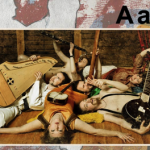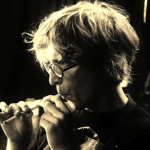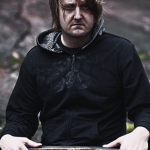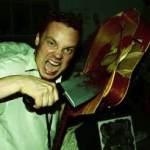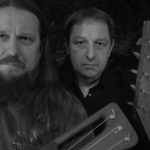Sääksmäki is a quiet village in western Finland on the road north from Helsinki to university town and Finland’ first industrial city Tampere. It boasts a 15th century cathedral containing wooden sculptures from an earlier church, a suspension bridge over the spectacular lake Vanajavesi and various manor houses, one of which, Voipaala, dating back to the 14th century, has been converted into a cultural centre. The remains of an ancient hill fort are set in a track which rises to a ridge from which one gets a fantastic view of the lake surrounded by spruce, birch, oak and other trees. Every year for the past decade Voipaala has been taken over by ethnomusicology graduates from the university of Tampere for the Uulu Fest, a three-day event which displays and runs workshops on various Finnish and other indigenous musical instruments from kanteles and jouhikkos to djembes and Hawai’ian log drums. Uulu means “force’ in ancient Finnish, and the group operates as a cultural cooperative run from Tampere and chaired by Lari Aaltonen, a postgraduate at Tampere University (http://www.uulu.fi/en).
Their aim is to promote music and musical ideas from non-Western countries as well as traditional and historical Finnish music. There was also an instrument-making workshop at Uulu run by Juhana Nyrhinen, the guy who makes kanteles out of skateboards, among many other things. The festival culminates in a concert by folk musicians based in Tampere. This was split into two parts – the first held on the upper floor of the main pine wood manor house, the second in a clearing in the forest reached along a rocky track with lanterns made from candles. It’s a magnificent location in the heart of the Finnish countryside and the music definitely matched the setting.
First up in the manor house were Aalto (http://etnoaalto.blogspot.be/) which means “Wave’, a six-piece group who have released an album on the home-grown Uulu Records, and combine what has been described as “the classical traditions of Northern India … (and) Tuvan throat singing while the psychedelic echoes of interstellar clarinet dance to the odd time signatures of kantele’. Lead singer Petra Poutanen plays an electrified stand-up kantele set up like a slide guitar, while other musicians double on electric guitar and sitar (Antero Mentu), clarinet and bass clarinet (Panu Ukkonen), banjo, bass guitar and mandolin (Marko Niittymäki), and the other singer, Sampo Salonen, combined Tuvan throat-singing with a three-string doshpuluur (a long-necked Tuvan lute made from wood) and didjeridu, although the latter wasn’ in evidence tonight (maybe fortunately!). The music transcends the label “world music’ as its Finnish characteristics remain dominant, producing rich, melodic, multi-layered textures which are highly seductive. Aalto have received favourable mentions on the psychedelic folk and the prog archives, so they appear to be crossing genres successfully.
They were followed by Pekko Käppi, a feral folk outsider, jouhikko virtuoso and Fonal recording artist who is fast becoming one of my favourite musicians. (http://pekkokappi.com/)
This time he was accompanied by his wife Petra as Käppi & Käppi on vocals and an ilimba (Tanzanian thumb piano, similar to the mbira from Zinbabwe) which looked like a large ancient book. Pekko sings traditional runo-poems and folk ballads, and was invited to perform unaccompanied at the London Poetry Parnassus in 2010, while his wife Petra was drawing on African traditions, with a powerful voice which had overtones of ululation, but again the Finnish elements seemed uppermost. Käppi reappeared later in the forest along with fellow jouhikko player Ilka Heinonen singing a decidedly rough, raw and pagan-sounding ballad, while his jouhikko, from which you can almost hear the grainy horsehair textures of the bow and strings, produced a decidedly acoustic Velvet Underground (or Tony Conrad) type of sound which cut through the forest silence.
Next up were the ironically-named Sitar Heroes, a highly entertaining trio consisting of two sitar players (Antero Mentu from Aalto and Lari Aaltonen), and a tabla player, Sami Rönkä, who delivered an evening raga in Indian tunics which definitely steered the atmosphere away from Finnish folk. The headliner was the amazing Ville Leinonen, another Fonal recording artist with a relatively long and varied career and just an acoustic guitar who created the biggest surprise for me. Wearing a French-styled blue and white striped matelot vest, he was clearly showing his Serge Gainsbourg and chanson influences on his sleeve, but he gave a fiery, passionate, hyper-energised performance which incorporated all kinds of violent strums and thrums, percussive guitar sounds, angular body moves, onomatopoeic vocal buzzes, blows, spits and blasts, culminating in a final song without microphone or guitar pick up which had the audience enraptured. His extraordinary vocalisations reminded me of John Cale’ howls and screams in his solo performances, and the frustration of not being able to understand his lyrics was intense.
We then began our candle-lit and torch-lit trek through the pitch black forest carrying plastic cushions to a makeshift sloped stage lit by constellations of candles, with the stars visible through the tree tops. It was hard to see the performers clearly, but the sound carried clearly through the bush. These included kantele and vocal duo Teppanan Veljet, who have been active in the Finnish folk scene for a number of years, have performed with Käppi among others, and are named after the famous traditional kantele player Teppana Jänis, who played a century ago.
Finally, singer-songwriter and jouhikko player Tytti Metsä began reciting from the Kalevela, the Finnish epic poem from Medieval times first published in 1835 and a huge influence on all forms of Finnish music from Sibelius to black metal. She then started singing the repetitive-sounding rhymed rune songs unaccompanied. It was an acousmatic experience, as I couldn’ see her but could hear her voice clearly, but not understanding Finnish, I hadn’ a clue what she was singing about, and could only hear the rhythm of the repeated trochaic tetrameters, which seemed to go on endlessly like a religious litany. After a while the audience joined in with a call-and-response dynamic, repeating the strophes that she sang. It was a strangely moving experience, sitting in the middle of the forest in the dark with candles flickering and stars twinkling overhead through the trees. Given there is little or no information about Metsä on the internet in English she remains something of an enigma. All that was left to do was a trek back through the dark and a 90 minute car trip back to Helsinki, thankful that Uulu exists and could introduce me to these mysterious hybrid sounds of Finnish folk music.

